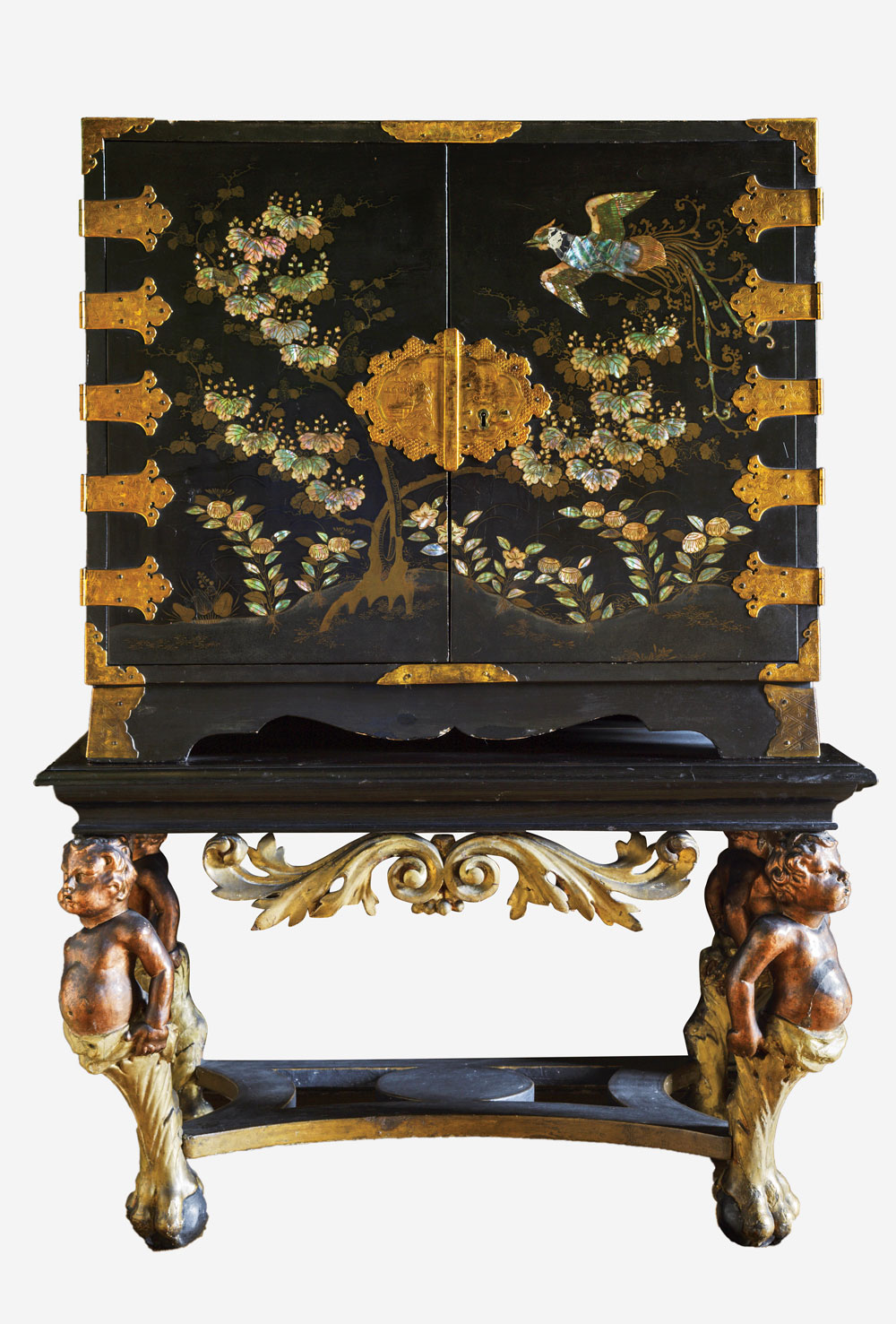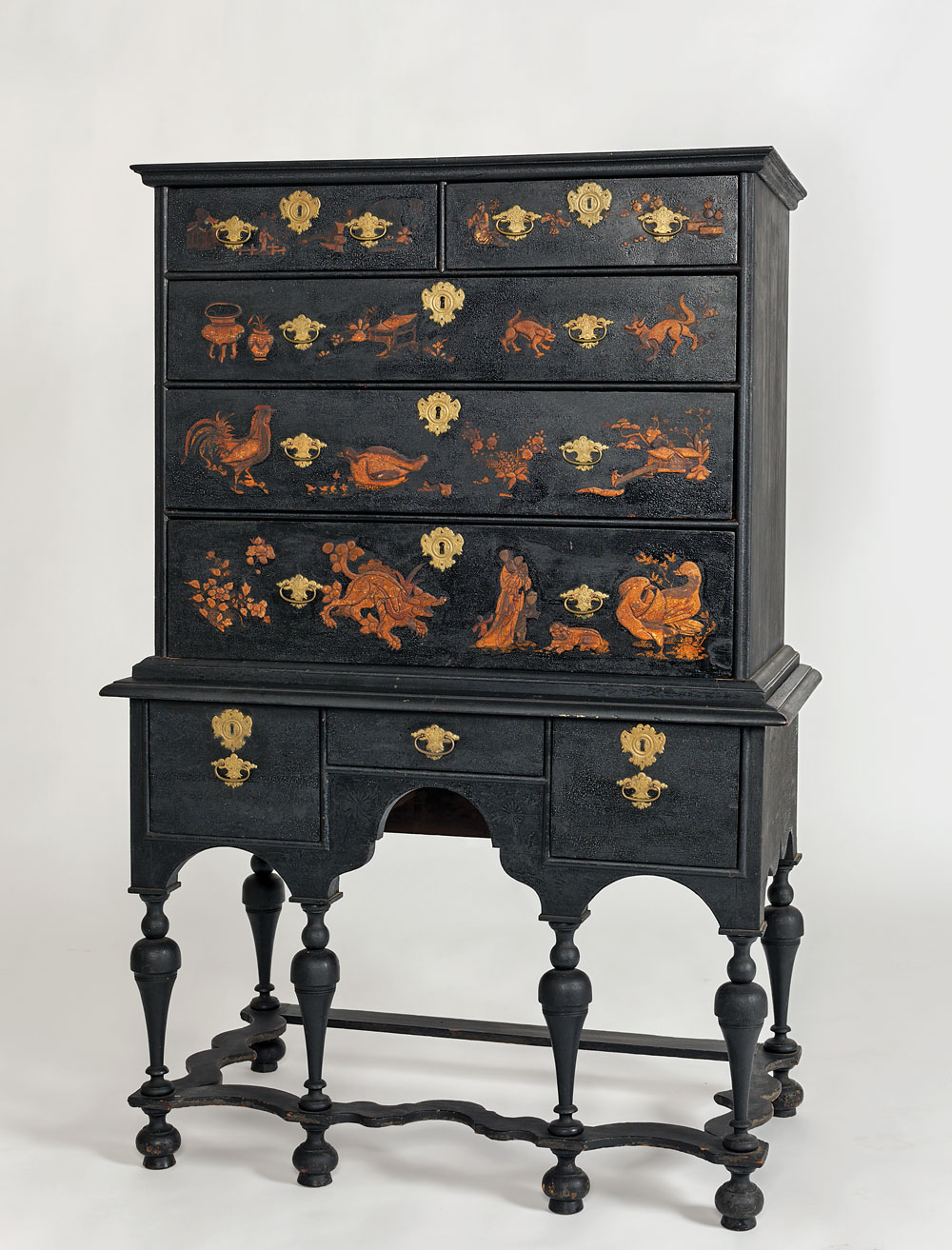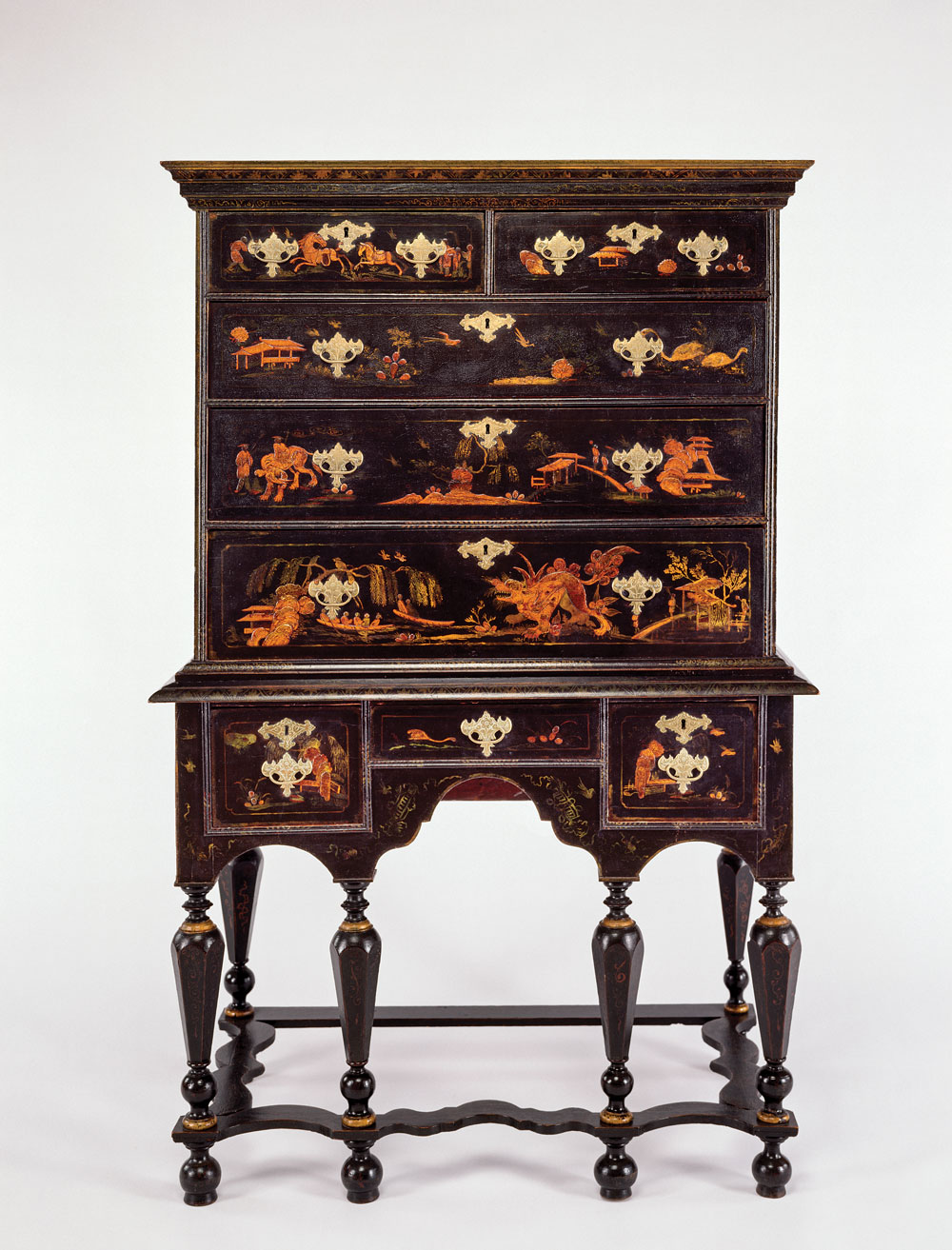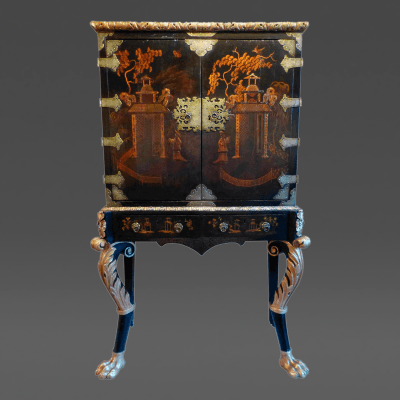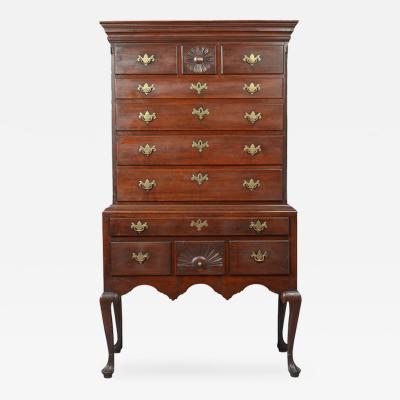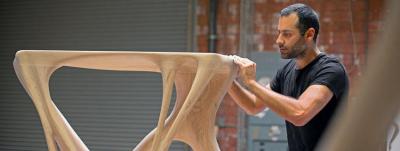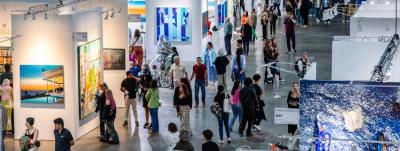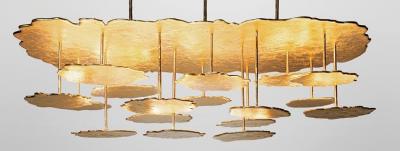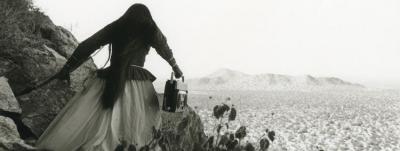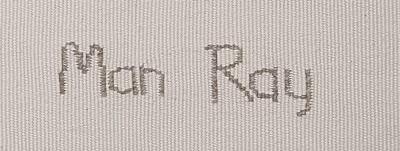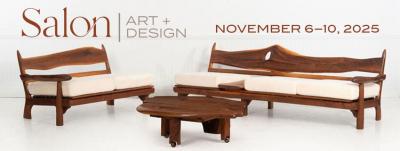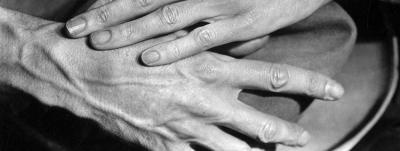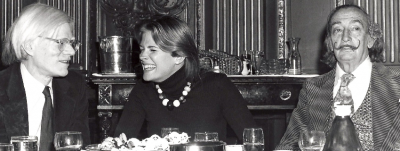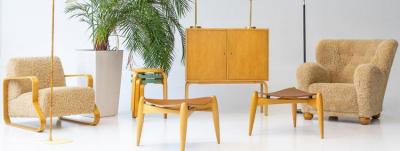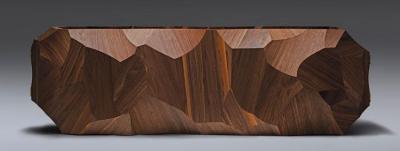Decorative Japanning in Early Eighteenth-Century Boston
A Tale of Two High Chests
Japanned furniture from Boston, with its whimsically decorated surfaces depicting visions of faraway worlds and exotic beasts, has long captured the imagination of collectors and curators alike (Fig. 1). Yet precious little is known about the workshops in which these wonderful objects were made. A few examples bear the signature of the highly skilled decorators known as “japanners,” but most were decorated anonymously.1 The authors have devoted the last few years to studying all known examples of Boston japanning, tracking provenance, comparing imagery, and documenting the methods and materials used to execute these Asian-inspired designs in the hope of learning more about the shop tradition in Boston and the people who were involved in this unique form of ornamentation.
The story of japanning in eighteenth-century Boston begins even earlier in Europe. By the seventeenth century, England and many other European countries fell under the spell of the Asian aesthetic, introduced with the opening of trade with the Far East. Two of the primary purveyors of this new design sense were the English East India Company and the Dutch East India Company. Both were established in the first years of the seventeenth century with the intent of trading directly with Japan, China, and India. Porcelains, silks and lacquerware, all goods that could not be produced in Europe at the time, were suddenly available to those who could afford these new luxuries. The homes of the wealthy began to acquire an exotic flair, but the market was so great for these goods that there was simply not enough available to satisfy the growing demand.
Among the most prized imports was East Asian lacquer, a remarkable material derived from the sap of various tree species. Both durable and beautiful, its glossy black surface enhanced with stylized gold designs made it highly desirable. In response to the dearth and expense of lacquer goods, as well as the impossibility of obtaining the raw material, English and European craftsmen endeavored to recreate its visual likeness by experimenting with the resins and colorants that were most familiar and available to them. The English term that came to describe this imitation of East Asian lacquerwork was “japanning.” This descriptor suggests the mistaken view of Asian geography that most people had at this time, believing that “Japan” encompassed China, India, and all of Southeast Asia. English and European craftsmen became highly skilled at imitating the glossy look of lacquer, which they then embellished with gold leaf and metallic powders, recreating the designs found on both lacquer and porcelain imports. When applied to furniture and smaller items the resemblance to true lacquerwork was often striking, being convincing enough to satisfy many consumers.
Some of the earliest objects to arrive from Asia were lacquer chests (Fig. 2). These precious lacquer objects were raised off the floor on gilt wood bases. The earliest English japanned chests often took the same form of a raised box or “cabinet on stand” in direct imitation (Fig. 3). It is not hard to see how this form eventually transformed into the high chest of drawers known in both England and Colonial America.
The desire for furniture decorated in the Asian style took root in the colonies only in early eighteenth-century Boston; no eighteenth-century japanned objects survive from any other colonial city. This demand for japanned furniture, and probably smaller decorative items as well, was met by a small number of London craftspeople trained in the technique of japanning and who immigrated to and settled in Boston.2 They in turn taught others and the tradition of japanning in eighteenth-century Boston was established.
By carefully observing and documenting the decoration on the fifty-four known surviving examples of Boston japanning, it is clear that these japanners followed certain strict protocols when decorating an object. Initially, the object was colored with several coats of varnish to resemble Asian lacquer, mixing in either black pigment or creating a mottled combination of vermilion red and black commonly referred to as “tortoiseshell.” Then, a combination of “raised work” and “flat work” decoration, often copied directly from the techniques of Japanese and Chinese lacquerwork, formed the designs. The technique of raised work allowed certain parts of the decoration to stand out in relief by applying a thickened gesso material that was then gilded. Gilded decoration applied directly to the colored ground surface was known as flat work. Both raised work and flat work were further enhanced with fine black lines referred to in the period as “penwork.” The designs, which often imitated the imagery found on Chinese screens, ceramics, and lacquerware, included human figures, animals, birds, buildings, boats, trees, bridges, and bouquets of flowers. These designs enhanced the surfaces of high chests, dressing tables, clock cases, and mirror frames with little regard for realistic scale (Fig. 4).3 The images were nearly always constrained by a single or double line, which followed the edges of a drawer or case side. All examples of Boston japanning from the first half of the eighteenth century exhibit these characteristics.
In 1933, The Metropolitan Museum of Art hosted the first and only exhibition devoted to American japanning. Lasting only a few weeks, the exhibition included high chests of drawers, dressing tables, a tall case clock, and a looking glass juxtaposed with ceramics from Japan, China, and Holland.4 While small in scale, the exhibition was the inspiration for several studies and articles.5 In the coinciding edition of the Bulletin of The Metropolitan Museum of Art, scholar Joseph Downs aptly describes japanned decoration as “a medley of fabulous beasts and birds, comely little human figures, pagodas, and flowering trees that jostled one another in a lively and incongruous confusion.” 6 Included in the exhibition was a high chest of drawers with perhaps the most “fabulous” of all beasts to be found on any American japanned piece of furniture— an elaborate winged dragon that marches menacingly across the bottom drawer of the upper case (Figs. 5, 6). More than eight decades later and now part of the collection of Historic New England, the high chest resides in the Winslow Crocker House in Yarmouth Port, Massachusetts (Fig. 7). This object has not been published or studied comprehensively since its inclusion in the exhibition of 1933.7
The early history of this high chest with its turned-leg base is unknown. In 1933, it was owned by Helen L. Bayley of Hyannis, Massachusetts. By 1956, the chest was in the Winslow Crocker House; the house and its contents were donated to the Society for the Preservation of New England Antiquities (now Historic New England) by Mary Thacher, an early and avid collector on Cape Cod. While no records exist for many of her purchases, she was known to have frequented auctions and dealers on Cape Cod and in Boston.8 With Hyannis less than five miles from where the high chest currently resides, it is entirely conceivable that Mary Thacher purchased the chest directly from Helen L. Bayley.
On an unseasonably warm day in January of 2013, we travelled to Yarmouth Port to examine this high chest with Nancy Carlisle, senior curator of collections at Historic New England. Armed with exam lights, cameras, and a tripod we climbed the narrow stairs in the house and snaked our way around the shrouded furniture protected for the winter season. There, in an upstairs chamber, stood the object of our interest. We were immediately struck by the unusual state of preservation of the raised ornament on its decorated surface. Having by then examined more than forty of the known fifty-four pieces of American japanned furniture, we were acutely aware that very few have survived without considerable deterioration and related restoration efforts. As we looked at the decoration, we were reminded of the japanned high chest in the Virginia Museum of Fine Arts (Fig. 8). It too had an image of a winged dragon that was strikingly similar (Fig. 9). Could this be evidence that japanners employed templates or stencils derived from print sources or craftsmen’s manuals to create these distinctive designs? At the start of our project we were sure that we would find many examples with identical imagery, however, until this discovery we had found very few. While many earlier researchers have suggested that the well-known seventeenth-century manual A Treatise of Japaning [sic] and Varnishing by John Parker and George Stalker published in 1688 in London was a source of these designs, there are no images on any extant American japanned object drawn from this publication.
Our ongoing study has revealed that despite a strict adherence to layout protocols, there are surprisingly few exact replications of designs among the imagery on compared pieces. While there may be similar subject matter, the execution is always varied. This suggests that the japanners may have used drawings, imported lacquerware, ceramics, or other forms of inspiration, but not templates, allowing themselves considerable creative freedom when executing the designs freehand. When comparing the imagery, we observed that although similar, the winged dragons on the two high chests are not identical, suggesting that they were “inspired” by a drawing or sketch. Interestingly, one image is reversed, further supporting the notion that a drawing created by the japanner, and not a pattern, may have been used to guide the japanner’s hand.
The two winged dragons also share another similarity not found on any other Boston japanned example, but seen in many European examples—fine detail carved with chisels into the raised ornament to give sharper definition to the design. The techniques and materials used for the creation of “Chinese style” decoration are described in Stalker and Parker. Their book, a guidebook for amateurs, provides instructions for imitating Japanese “raised work” by mixing a paste of chalk and gum arabic and dribbling it onto the areas to be picked out in relief. The last step before gilding the raised work is to carve fine lines with chisels into the dried paste to give the decoration a more detailed and lively appearance (Figs. 10, 11). The authors of A Treatise point out “the difficulty of the enterprise,” and warn that “no heavy, rustik [sic] hand must be emploied [sic] in this tender, diligent work,” which will be made easier if your tools have “an exquisitely sharp and smooth edge, whereby they may cut clean and fine without roughness.” 9
We have observed that on the majority of Boston japanned objects the raised work is created quickly and expeditiously, using multiple applications of paste to create different heights in raised detail without taking the extra time to carve fine detail or enhance the raised elements in any other way. The two exceptions to this are the high chests with the winged dragons.
When comparing the other imagery on both pieces, they were surprisingly quite different. The high chest from the Virginia Museum of Fine Arts exhibits imagery typical of Boston japanned work—buildings, figures, three-leaf floral forms, birds, a bridge, and piles of rocks. It also includes a man riding an elephant, the only known depiction of an elephant on a Boston example, although we have noted a few on English pieces (Fig. 12).
By contrast, the Historic New England high chest has much more unusual and complex imagery—a crouching lion, a pea hen on a nest with chicks, a rooster, two wood ducks and two dogs. It also contains the image of a vase and a bowl with peacock feathers—both borrowed directly from Chinese Coromandel screens. The craftsperson who created the imagery on this high chest was obviously conversant in the vocabulary of ornament found on Chinese screens. A small resting lion depicted (Fig. 13) on the lower drawer of the upper case, for instance, is remarkably similar to the image of a pair of bronze water droppers, part of the “hundred antiques” iconography carved into a Coromandel screen in a private collection (Fig. 14).
The similarity of the two winged dragons, and the fact that the raised ornament has been carved on both chests, suggests they were decorated by the same japanner. Studying the japanner’s execution of flat work and “pen work” is also an effective way to discern the hand of a particular decorator, as his (or her) style is as unique as a signature.10 Unfortunately, like most examples of early eighteenth-century japanning, these two objects have had several campaigns of restoration. Historic New England’s high chest has had extensive repainting of the black background, obscuring the delicate flat work ornament and leaving only the well-preserved raised work exposed. The Virginia Museum of Fine Art’s example exhibits restoration to the flat work as well as some of the raised ornament. This obscured detail in some of the original work has made it a challenge to see the full range of the decorator’s skill; fortunately, details are visible in the two dragon figures.
Although at this point we cannot identify the name of the japanner who may have decorated the two high chests, the use of the unique winged dragon design element and the specific carving technique to enhance the raised ornament suggests that both chests were decorated by the same individual. We hope that through continued investigation, little discoveries will eventually coalesce into a comprehensive understanding of the working practices of the few highly skilled immigrant craftsmen who brought the remarkable art of japanning to eighteenth-century Boston.
-----
Tara Cederholm is the curator and Vice President of Brookfield Arts Foundation. Since 1993, she has been the steward of a collection focused on American furniture and decorative arts as well as Chinese furniture, ceramics, and related decorative arts. Christine Thomson is a furniture and object conservator in private practice in Salem, MA. Her work is primarily focused on the treatment of surface decoration.
Since 2012 the authors have been working together researching all known examples of Boston japanned furniture. They have recently expanded that research to include English work as well.
This article was originally published in the 17th Anniversary issue of Antiques & Fine Art magazine, a fully digitized version of which is available at afamag.com. AFA is affiliated with Incollect.
2. For a discussion of the role of immigrant japanners to Boston see op. cite. Cederholm and Thomson, 60.
3. For a fuller discussion of these possible design sources see Cederholm and Thomson op. cite, 56–58.
4. Two of the high chests and one chest of drawers were not japanned but were paint-decorated examples from Windsor, Connecticut. The authors are indebted to Morrison Heckscher for sharing information about this exhibition, including a checklist of objects, installation images, and his research into the current location of pieces lent by private collectors.
5. See Joseph Downs, “American Japanned Furniture” in Bulletin of the Metropolitan Museum of Art (March 1933), “American Japanned Furniture,” in Bulletin of The Metropolitan Museum of Art (1940); Esther Stevens Brazer, “The Early Boston Japanners,” Antiques (May 1943); 208-211; Mabel Swan “The Johnstons and the Reas—Japanners,” Antiques (May 1943); 211–213; Gertrude Z. Thomas, “Lacquer: Chinese, Indian, ‘right’ Japan, and American,” Antiques (June 1961); 572–575; Richard Randall, “William Randall, Boston Japanner,” Antiques (May 1974); 1127–1131; Elizabeth Rhoades and Brock Jobe, “Recent Discoveries in Boston Japanned Furniture,” Antiques, (May 1974); 1082–1091; Alyce L. Perry, “The Best ‘Blew’: A Rare American Blue Japanned Tall-Case Clock,” Antiques (May 2009); 125–127; Phyllis Whitman Hunter, “Japanned Furniture: Global Objects in Provincial America,” Antiques (May 2009); and Ethan W. Lasser, “Reading Japanned Furniture,” American Furniture, Chipstone Journal (2007):168–190.
6. Downs, Bulletin, 42–48.
7. Images of the high chest have recently been added to the Historic New England website.
8. See http://www.historicnewengland.org for more information about the Winslow Crocker House, Mary Thacher, and the collections.
9. John Stalker and George Parker, “A Treatise on Japanning and Varnishing” originally published 1688 (London, reprint Alec Tiranti, London, 1960), 34
10. There are one or two women listed as japanners in Boston in the eighteenth century, and it is possible that japanning may have been a woman’s profession as well as a man’s.
















